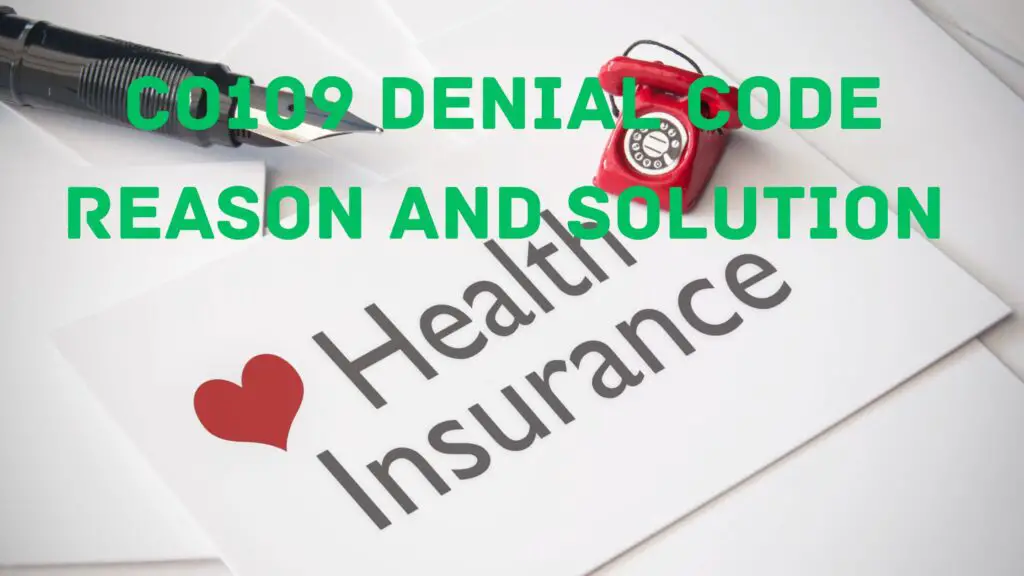Denials are playing a very important part in medical Billing, If denials are handled very carefully then revenue increased automatically. CO 109 Denial Code is a common denial in RCM so we learn how to handle this denial.
Table of Contents
- CO 109 Denial Code Descriptions
- Co109 Denial Code Handling
- COB- Coordination of Benefit Rule:
- Related Article:
CO 109 Denial Code Descriptions
Co109 denial code means Claim or Service not covered by this payer or contractor, you may send it to another payer or covered by another payer.
Co109 Denial Code Handling
If denial code co109 reason in claims that mean the patient has another payer or insurance and the patient did not update info that which is primary ins and which is secondary ins. Mostly due to this reason denial CO-109 or covered by another payer denial comes.

The below steps we have to follow to handle this denial
When encountering the denial message “Claim or Service not covered by this payer or contractor” in medical billing, there are several steps you can take to handle the situation effectively:
- Review the denial: Carefully read the denial message to ensure you understand the reason for the denial. It might indicate that the specific payer or contractor does not provide coverage for the service or procedure you billed.
- Verify patient coverage: At the first user should check patient eligibility on a given website if found other insurance information is already updated then the claim is billed to that insurance as the correct one. Double-check the patient’s insurance information and policy details to confirm whether the service should be covered. Contact the insurance company or review the payer’s coverage policies to ensure the denial is accurate.
- If no website is available to check eligibility then user should call the insurance company that gave denial and ask them if there is any other ins information available, some times they provide other insurance information with a policy id number and active and term date. User should update information and bill that one.
- Review documentation: Examine the medical documentation to ensure the service or procedure was appropriately coded and documented. Confirm that the procedure was necessary and adequately documented to support the medical necessity.
- Appeal the denial: If you believe the service should be covered based on the patient’s policy or if there was an error in processing the claim, consider filing an appeal. Follow the payer’s specific appeal process, which typically involves submitting a written letter detailing why you believe the denial is incorrect and attaching any relevant supporting documentation, such as medical records or policy guidelines.
- Communicate with the patient: If the payer does not cover the service, inform the patient about the denial and discuss potential options. Provide clear explanations regarding the patient’s financial responsibility and explore alternative payment options, such as setting up a payment plan.
- Explore alternative coverage: If the patient’s insurance policy does not cover the service or procedure, explore other potential sources of coverage, such as secondary insurance plans or government programs, to determine if any of them may provide coverage.
- Educate and update systems: Ensure that your billing and administrative staff are aware of the denial reason and update your systems or billing practices accordingly to prevent similar denials in the future.
Remember, specific insurance policies and procedures can vary, so it’s essential to familiarize yourself with the guidelines of the payer or contractor involved.
Note- Denial code 22 or CO 22 denial code also described as “This care may be covered by another payer per coordination of benefits” User should have followed the same procedure to handle the denial as above.
COB- Coordination of Benefit Rule:
COB is a short form of Coordination of Benefit. If the patient has more than one insurance coverage, then the COB rules determine and decide which will be the primary, and which one is secondary insurance and the tertiary as well. This rule is to avoid no duplication of payments and paid by the correct payer respectively.
When a patient is having more than one medical insurance policy, then it is the patient responsibility to update all of his/her insurance policy information and the order of payment as to which will be the primary and which one is secondary insurance.
Co 109 denial code and denial code 22 both are working in the same way and have very minor differences but mostly both are handled in the same way.
Related Article:
Medicare Advantage Plans: Your Path to Healthier Living
What is Denials Management in Medical Billing?
CO 24 Denial Code-Charges are covered under a capitation
CO 5 Denial Code| Procedure in Inconsistent with POS
CO 4 Denial Code | Procedure code is inconsistent with the Modifier used
- PR 96 Denial Code – Non-Covered Charges (2025)
- CO 24 Denial Code-Charges are covered under a capitation agreement
- CO 45 Denial Code- Charges exceed the fee schedule/maximum allowable
- CO 197 Denial Code – Pre-Certification or Authorization not Present (2025)
- CO 8 Denial Code – Procedure code inconsistent with provider specialty
- CO 109 Denial Code – Service Not Covered by this Payer (2025)
- EOB Codes List (2025)
- CO-29 Denial Code Description -Timely Filing Limit Expired
- CO 4 Denial Code – Procedure code is inconsistent with the Modifier
- CO 5 Denial Code – Procedure Code is Inconsistent with Place of Service
- CO-9 and CO-10 Denial Code Description
- OA 18 Denial Code – Exact Duplicate Claim (2025)
- PR 27 Denial Code Descriptions – Coverage Terminated (2025)
- Denial Code PR 119 | Maximum Benefit Met Denial (2025)
- PR 31 denial Code – Patient Can’t be identify Our insured
- CO 97 Denial Code Solution (2026)
- BCBS Commercial Insurance Denial Codes (2026)
- Medical Billing Denial Codes List (2026)
- Denial Code PR 204 Description (2026)
- CO 23 Denial Code Description (2026)
The author and contributor of this blog "NSingh" is working in Medical Billing and Coding since 2010. He is MBA in marketing and Having vaste experience in different scopes of Medical Billing and Coding as AR-Follow-up, Payment Posting, Charge posting, Coding, etc.

